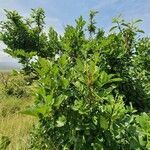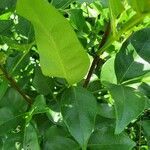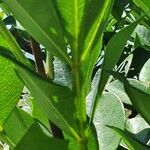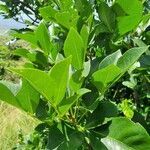Tree (said to occur occasionally as a subscandent shrub in Natal) from about 4 to 8 m tall with stem up to 30 cm in diameter, bark greyish or light brown in colour; branchlets glabrous or puberulous, not tomentulose. Leaves glabrous, 5-13 cm long, 5-foliolate, sometimes 3-foliolate; leaflets varying considerably in size, texture and shape, the lateral elliptic to broadly elliptic or oblong, unequally cuneate at the base, about 3-7 cm long and 1-4 cm broad, the terminal usually a little larger than the other leaflets, more obovate-oblong, sometimes elliptic, subsessile or cuneate into a petiolule up to 1 cm long; petiole and rhachis winged, wing variable, narrow or broad auricled at base or not. Inflorescence puberulous, about 6-11 cm long, the lateral branches slender, usually over 2 cm long; bracts deciduous, variable in size, some 5 mm long and 2 mm broad, often narrower, rarely broader. Calyx more or less tubular-turbinate, persistently puberulous outside, sometimes densely so, almost velvety, pubescent in upper portion within, more or less truncate and slit or variously lobed, persisting in fruit. Corolla sweetly scented, white suffused with pink or puce at different stages, tube cylindrical, about 1.4 cm long, glabrous or variously puberulous in parts outside, often pubescent with rather long hairs near the base within; lobes suborbicular, about 5 mm long, crenate on margins, spreading, with a cluster of glandular reddish-brown hairs near the base on inner face. Stamens 2, inserted near the apex of the corolla and then exserted or, in other specimens, below the apex and then included. Ovary 2-celled, about 1.5 mm long, somewhat flattened and puberulous on top, obscurely 2-lobed, ovules 10 cm each cell; pendulous; style about 1.5 cm long, glabrous or sometimes sparsely pubescent with sho patent gland-tipped hairs, long exserted in flowers with stamens included and vice versa; stigma about 1-5 mm long, obscurely 2-lobed. Capsule green when young (turning black on drying) becoming light brown at maturity, puberulous except at base within calyx, obovate-oblong, slightly laterally flattened at right angles to the septum, parallel to the wall of division, with a ridge along the septum. Seeds 8 mm long with an oblong 1.1 cm x 6 mm subterminal wing (degree to which wing runs down one side varies, also the width).
Shrub or tree, 9–24 m. tall, with pale grey bark, vegetative branches grey or ochraceous, glabrous, with numerous rather prominent lenticels.. Leaves compound with two pairs of leaflets and an odd terminal leaflet, glabrous or the petiole and rhachis very shortly and usually slightly or rarely rather densely puberulous; rhachis more or less clearly winged and the petiole often auriculate at the base; leaflets elliptic-oblong to elliptic, rarely oblanceolate to obovate-elliptic, rounded to subacute, and often somewhat attenuated at apex, cuneate and the lateral ones sometimes oblique at the base, lateral 4.5–9.5 cm. long and 1.6–4.3 cm. broad, terminal up to 12 (18) cm. long, margin entire and flat, venation reticulate and subprominent, subcoriaceous.. Inflorescences terminal to short branches, cymosely branched, fairly compact, 4–6 cm. long, bracteolate, densely puberulous, many-flowered.. Calyx broadly campanulate, 5–6 mm. long, puberulous.. Corolla externally glabrous: tube about 1 cm. long.. Fruit obovate, 2.2–3.5 cm. long, 1.2–1.4 cm. in diameter, with woody valves.. Seeds (including the terminal and scarcely unilateral wing) oblanceolate, 2.5 cm. long, 9 mm. broad.. Fig. 1 (p. 3).
Tree or shrub, 4-15 m high. Leaves opposite, compound, imparipinnate with 5(7) leaflets; rachis usually winged. Inflorescences terminal, paniculate cymes. Flowers white to pink, heterostylous. Calyx loosely enveloping corolla, truncate or irregularly lobed. Corolla salver-shaped, tube well developed, cylindrical; segments 6 or more, spreading to reflexed, each with a group of swollen, brown to purplish hairs at base. Stamens 2, arising on corolla; anthers longer than filaments. Ovary small, truncate; style filiform; stigma bifid. Flowering time Oct.-Jan. Fruit a woody, bivalved capsule, with loculicidal dehiscence, ± clavate. Seeds 4 per locule, winged.
Corolla tube 8–12 mm. long in “pin” flowers, 11–16 mm. in “thrum” flowers, usually pilose inside; lobes (5) 6–7, 3–7 x 2–6 mm., unevenly obovate with apex usually bilobed, each with a triangular patch of brownish dilated hairs extending from the corolla mouth up to 1/2 the length of the petal.
Leaves imparipinnate with 5 (7) leaflets, the terminal leaflet and distal pair inserted together; leaf axis distinctly articulated at leaflet insertion; petiole and rhachis ± equal in length (in leaves with 5 leaflets).
Total leaf length 6–26 cm.; terminal leaflet 3–14 x 1·2–5·5 cm., laterals 2–12 x 1–5 cm.; leaflets elliptic or obovate, rounded to acuminate at apex; terminal leaflet tapered at base, laterals acute or tapered.
Tree, 4-15 m high. Leaves imparipinnate, 5(7)-folio-late. Inflorescence several-to many-flowered, with pedicels up to 2 mm long. Fruit clavate, containing 8 winged seeds. Flowers white suffused with pink.
A tree 4–15 m. tall, or sometimes a small bush; trunk slightly fluted; slash cream, becoming darker with exposure; bark pale brown or grey, fairly smooth, with short longitudinal fissures.
Fruit a woody bivalved capsule 2·5–4·5 cm. long, brown, ± clavate, with wrinkled surface, splitting open at maturity to reveal two locules divided by a papery dissepiment.
Inflorescence a terminal several–to many–flowered cyme 4–9 cm. long with deciduous bracts and bracteoles and glabrous to tomentose branches; pedicels up to 2 mm. long.
Stamens inserted near the top of the corolla tube (“pin” flower) or at the mouth (“thrum”); anthers 1·25–1·5 (2) mm. long, on filaments up to 1 mm. long.
Petiole and rhachis often winged, glabrous or pubescent; lamina glabrous above, glabrous or sparsely pilose below especially on main veins.
Young branches glabrous or thinly to densely tomentose, older twigs with very conspicuous lenticels.
Calyx 2–4 mm. long, minutely puberulous to pubescent, truncate or very unevenly dentate at apex.
Style correspondingly of 2 lengths, either exserted from or slightly shorter than corolla tube.
Flowers white to pink, sweet–scented, heterostylous with “pin” and “thrum” forms.
Seeds 4 per locule, c. 2 cm. long, pendulous.
Tertiary vein reticulation conspicuous.





